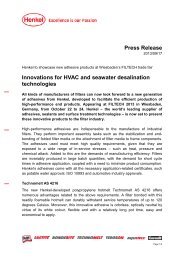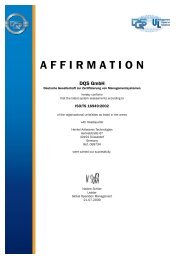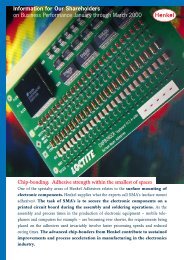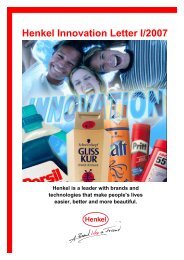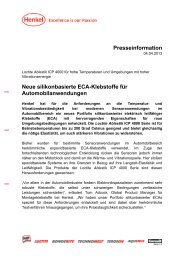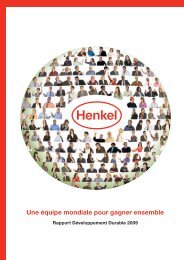Henkel Annual Report 2011 - Henkel AG & Co. KGaA Annual Report ...
Henkel Annual Report 2011 - Henkel AG & Co. KGaA Annual Report ...
Henkel Annual Report 2011 - Henkel AG & Co. KGaA Annual Report ...
Create successful ePaper yourself
Turn your PDF publications into a flip-book with our unique Google optimized e-Paper software.
136 <strong>Co</strong>nsolidated financial statements<br />
Notes to the consolidated statement of financial position<br />
<strong>Henkel</strong> <strong>Annual</strong> <strong>Report</strong> <strong>2011</strong><br />
Cash flows from financial liabilities<br />
December Up to<br />
Remaining term<br />
Between More than December<br />
31, <strong>2011</strong> 1 year 1 and 5 years 31, <strong>2011</strong><br />
Carrying<br />
5 years<br />
Total<br />
in million euros<br />
amount<br />
cash flows<br />
Bonds 1 3,670 284 3,644 – 3,928<br />
<strong>Co</strong>mmercial papers 2 29 29 – – 29<br />
Liabilities to banks 209 201 12 2 215<br />
Trade accounts payable 2,411 2,411 – – 2,411<br />
Sundry financial instruments 3 68 61 4 3 68<br />
Original financial instruments 6,387 2,986 3,660 5 6,651<br />
Derivative financial instruments 75 45 30 – 75<br />
Total 6,462 3,031 3,690 5 6,726<br />
1 The cash flows from the hybrid bond issued in 2005 are disclosed for the period until the first possible redemption date by <strong>Henkel</strong> on November 25, 2015.<br />
2 From the euro and US dollar commercial paper program (total volume: 2.1 billion euros).<br />
3 Sundry financial instruments include amounts due from customers and finance bills.<br />
Market risk<br />
Market risks exist where the fair value or future cash flows<br />
of a financial instrument may fluctuate due to changes in<br />
market prices. Market risks primarily take the form of currency<br />
risk, interest rate risk and various price risks (particularly<br />
the commodity price risk).<br />
The <strong>Co</strong>rporate Treasury department manages currency exposure<br />
and interest rates centrally for the Group and is therefore<br />
responsible for all transactions with financial derivatives<br />
and other financial instruments. Trading, Treasury <strong>Co</strong>ntrolling<br />
and Settlement (front, middle and back offices) are separated<br />
both physically and in terms of organization. The parties<br />
to the contracts are German and international banks<br />
which <strong>Henkel</strong> monitors regularly, in accordance with <strong>Co</strong>rporate<br />
Treasury guidelines, for creditworthiness and the quality<br />
of their quotations. Financial derivatives are used to manage<br />
currency exposure and interest rate risks in connection with<br />
operating activities and the resultant financing requirements,<br />
again in accordance with the Treasury guidelines. Financial<br />
derivatives are entered into exclusively for hedging purposes.<br />
The currency and interest rate risk management of the Group<br />
is supported by an integrated treasury system which is used to<br />
identify, measure and analyze the Group’s currency exposure<br />
and interest rate risks. In this context, “integrated” means<br />
that the entire process from the initial recording of financial<br />
transactions to their entry in the accounts is covered. Much<br />
of the currency trading takes place on internetbased, multibank<br />
dealing platforms. These foreign currency transactions<br />
are automatically transferred into the treasury system. The<br />
currency exposure and interest rate risks reported by all subsidiaries<br />
under standardized reporting procedures are integrated<br />
into the treasury system by data transfer. As a result,<br />
it is possible to retrieve and measure at any time all currency<br />
and interest rate risks across the Group and all derivatives<br />
entered into to hedge the exposure to these risks. The treasury<br />
system supports the use of various risk concepts.<br />
Market risk is monitored on the basis of sensitivity analyses<br />
and valueatrisk computations. Sensitivity analyses enable<br />
estimation of potential losses, future gains, fair values or<br />
cash flows of instruments susceptible to market risks arising<br />
from one or several selected hypothetical changes in foreign<br />
exchange rates, interest rates, commodity prices or other<br />
relevant market rates or prices over a specific period. Sensitivity<br />
analyses are used in the <strong>Henkel</strong> Group because they<br />
enable reasonable risk assessments to be made on the basis of<br />
direct assumptions (e.g. an increase in interest rates). Valueatrisk<br />
computations reveal the maximum potential future<br />
loss of a certain portfolio over a given period that, based on a<br />
specified probability level, will not be exceeded.<br />
Currency risk<br />
The global nature of our business activities results in a huge<br />
number of cash flows in different currencies. The resultant<br />
currency risk breaks down into two categories, namely<br />
transaction and translation risks.<br />
Transaction risks arise from possible exchange rate fluctuations<br />
causing changes in the value of future foreign currency<br />
cash flows. The hedging of the resultant exchange rate risks<br />
forms a major part of our central risk management activity.<br />
Transaction risks arising from our operating business are<br />
partially avoided by the fact that we largely manufacture our<br />
products in those countries in which they are sold. Residual<br />
transaction risks on the operating side are proactively<br />
managed by <strong>Co</strong>rporate Treasury. This includes the ongoing<br />
assessment of specific currency risk and the development of<br />
appropriate hedging strategies. The objective of our currency<br />
hedging is to fix prices based on hedging rates so that we are<br />
protected from future adverse fluctuations in exchange rates.



